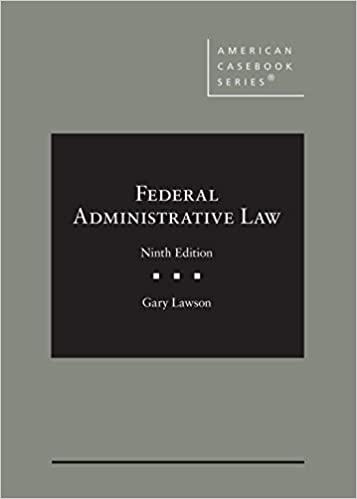1. For Case A, choose THREE of the categories below fromthe Charter of Rights and Freedoms. For each category you chose, give one example of a violation of rights that occurred in that category.
a. Fundamental Freedoms (s. 2)
b. Mobility Rights(s. 6)
c. Legal Rights(ss. 7-14)
d. Equality Rights(s. 15)
2. For each of Cases B and C, discuss whether assault, battery, orboth occurred. Use the terms "plaintiff", "defendant", and "liable".
3. Why do you think the judge decided in Case C that the defendant's actions were not justifiable as self-defense? Consider the plaintiff's actions and the defendant's response.
4. Explain how the principle of contributory negligence applies in Case D.
5. In Case of
CASEA APEC Conference ('I 99? British Columbia] A group of world leaders came to Vancouver to attend a trade conference. The conference took place in various locations throughout the city, including a well-known university. As the leaders arrived at the airport, many protesters came to demonstrate against the leader of a country known for human rights abuses. They stood at the side of the road holding signs saying "Freedom of Speech" and \"Human Rights\". The police took away the protestors' signs so they would not emba rrass the leaders. A few days before the conference, dozens of student protesters organized a \"tent citY' at the university campus. They planned to camp on the grass in front of the Student Union Building until the leaders arrived for the conference. The police arrested the protestors and took them to a jail in Richmond before the leaders arrived. The police did not inform the protestors of the reasons for their arrests, nor did they charge them with any crimes. They refused to allow the protestors to communicate with their lawyers, and they strip-searched several female protestors. 0n the day of the conference, a large protest took place on campus. Although the police had built a temporary fence to keep protestors a few city blocks away from the conference, a few protestors began to shake the fence. The police respond by pepper-spraying about 'IOD protestors, almost all of whom were merely standing there peacefully. Students who were pepper-sprayed experienced extreme pain and had difficulty breathing. The day after the conference, the protestors who had been kept in the jail in Richmond were released without charge. but only after they signed a statement promising not to leave the Province of British Columbia for one month. (*Based on a true story - see: CBC News Video #1, CBC News Video #2) CASEB Stephens v. Myers(1830 United Kingdom) At a parish meeting, the defendant, Myers, threatened and attempted to assault the plaintiff, Stephens, who was acting as chairman. During the course ofan angry discussion, a majority of people at the meeting voted to kick out the defendant. The defendant said that he would rather pull the chairman out of his chair than leave the room. Then he rose from his seat and walked towards the plaintiff with his fist raised, but was stopped by the churchwarden, who sat next to the chairman, before he could get close enough to attack the chairman. The witnesses said that it seemed to them that Myers was advancing with the intention to strike Stephens. CASEC Tubeme v. Savage ('1 699 United Kingdom) During an argument, the plaintiff had put his hand on his sword and made the following statement: \"If the traveling judges were not in town right now. I would not take such language from you." Following this. the defendant struck the plaintiff, causing the plaintiff to lose his eye. The plaintiff successfully sued the defendant, who had to pay the plaintiff damages for assault, battery and wounding. The defendant claimed that the plaintiff had assaulted him rst. and that he was acting in self-defence. The judge disagreed. stating that the plaintiffs actions were not assault, and that the defendant's actions were not justied as selfdefence. CASED Dodgson v. Topoiinsky ('I 980 Ontario) Mnjustice Labrosse of the Ontario High Court ofjustice found driver Carol Dodgson 15% at fault in an accident because of her failure to wear her seatbelt, even though the other driver's negligence was the cause of the accident. The driver of the other car, Melva Topolinsky. had stopped momentarily at an intersection in a rural area. Then she moved out into the path of Dodgson's car. Dodgson suffered a severe scaip wound and shattered right knee. Her daughter also suffered minor injuries. Mnjustice Labrosse awarded the plaintiff $39,184.50 for her injuries. but then reduced this award to $33,306.82 because she was not wearing a seatbelt at the time of the accident. A person who does not wear a seatbeltwhile in a car is negligent in not taking precautions for personal safety. Therefore, if wearing a seatbelt would have prevented or lessened injuries suffered in an accident. damages will be reduced, even if the accident is totally the fault of the other driver. CASEE Campbell v. Royal Bank of Canada (1964 Manitoba} Campbell. the plaintiff, was a customer at one of RBC's branches in Brandon, MB. Visiting the branch one winter day, she slipped and fell on the oor, and was seriously injured. Between 7-8 cm of snow had fallen during the day, and customers had tracked slush that formed various wet spots into the bank. In particular, a dangerous glaze had formed near the tellers wicket that Campbell went to. No effort had been made by bank employees to wipe the oor at any time during the day; no mats were provided to customers to wipe their feet. The plaintiff had observed that the floor was wet in certain spots. but was not aware of the dangerous condition at the teller's wicket. The plaintiff won at trial court, and was awarded damages for her injuries, but lostwhen the defendants appealed to the Manitoba Court oprpeal. The plaintiffthen appealed the decision to the Supreme Court of Canada, who restored the original trial decision








